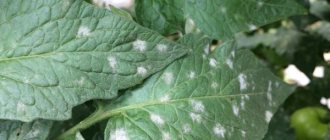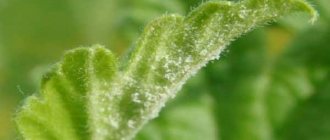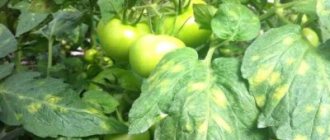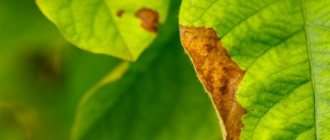Home / Pests and diseases
Back
Published: 10/28/2018
Reading time: 8 min
0
You can get a good harvest of tomatoes if you follow all the rules without exception, starting with planting seeds for seedlings. If the seedlings turn out to be weak or, worse, sick, then a generous tomato harvest is out of the question.
What are the main diseases that tomato seedlings suffer from? We have prepared a brief description with photographs of common diseases of tomato seedlings and simple and effective methods of treating them.
These diseases can be divided into several categories.
- 1 Fungal diseases
- 2 Rot
- 3 Viral diseases
- 4 Bacterial diseases
- 5 Non-communicable diseases
- 6 Preventive measures
- 7 How to treat tomato seedlings against pests?
Fungal diseases
These diseases often occur due to improper care. Water the seedlings regularly, but moderately. Do not allow the soil in the container to flood.
If the sprouts are located too close to each other, this leads to poor air circulation between them, and a fungal disease occurs.
The room where tomatoes grow should be as comfortable as possible for the development of sprouts: light, warm, not damp.
— Late blight manifests itself by the appearance of dark spots on the leaves. Soon the affected leaves begin to wither and fall off. Immediately tear out such sprouts and burn them. Treat the remaining sprouts with Zaslon. After two weeks, the seedlings will have to be treated again, but with the Barrier preparation.
To fully ensure that late blight does not occur on the tomatoes again, treat them again with a garlic-manganese solution. Dissolve 1 gram in a bucket of water. manganese and add garlic juice obtained from squeezing a glass of garlic cloves.
Blackleg attacks the stems of tomato seedlings. They become thin, the sprout does not receive life-giving moisture from the soil and soon dies. Remove diseased plants from the cup.
To avoid this disease, some gardeners add a little sifted wood ash and copper sulfate to the soil before planting seeds.
— White spotting is caused by fungal spores. White spotting initially manifests itself by the appearance of black dots on the lower leaves of the sprouts. Without taking immediate action, the disease quickly spreads throughout the plant.
Later the leaves turn black and fall off. If the disease is detected early, the seedlings can be completely saved by treating them with a solution of copper sulfate. Those sprouts that could not be saved should be pulled out and burned.
— Fusarium wilt is caused by a soil fungus. It attacks the roots of plants and causes them to wilt.
If you cut the stem of an affected plant, you will see some brown tufts. This is a manifestation of Fusarium wilt. The disease occurs from insufficient lighting in the room where tomatoes are grown, or from improper care of them.
Useful treatment tips
When identifying diseased plants, experts recommend:
- Move the diseased specimen to another location. When caring for it, use separate gloves and tools. Be sure to wash your hands thoroughly with soap after all procedures with such plants.
- First, you should work with completely healthy bushes, and then with diseased ones.
- Fertilize to strengthen the plant.
- After identifying and treating a certain disease, in the future do not forget about preventive treatments specifically against this type of disease. Healthy plants should also be treated.
- It is better not to use seedlings that are too diseased for planting, but to dispose of them.
There are folk recipes that help get rid of many tomato diseases:
- Spray the plants with this mixture - stir 100 g. baker's yeast in 10 liters of water.
- Grind 0.5 kg of garlic and leave in 3 liters for 5 days. Then 50 gr. dilute the resulting solution in a 10-liter bucket and add 50 g. crushed soap. Spray the seedlings with the resulting product.
- You can spray by mixing 1.5 cups of chopped garlic and 2 grams in 10 liters of water. manganese
Such spraying is recommended to be repeated after 10–14 days to consolidate the effect.
Did you know? Most chefs (68%) prefer canned tomatoes when preparing dishes, as they have a richer aroma and taste.
Preserved foods such as tomato ketchup and tomato paste contain much more of the natural antioxidant lycopene than fresh fruits. For tomatoes, it is more important to prevent the disease than to fight it later. Today, many simple and effective preventive measures are known to avoid diseases. Do not forget about creating conditions for tomatoes - a more developed plant will more successfully resist all adversities.
Rotten
Rotting of tomato sprouts occurs from too low ambient temperatures or from excessive watering. The first sign of the disease is a change in the color of the leaves of the seedlings. Later, mucous spots with a fungal coating appear on them.
As soon as you notice a change in the color of the leaves, immediately reduce watering and bring the air temperature in the room back to normal. Spray the tomato seedlings with a solution of copper oxychloride, but first pick off all the affected leaves. After two days, treat the tomatoes with a two percent solution of trichodermin.
NOTE: Steaming the soil before sowing seeds can prevent the development of white rot.
— Cladosporiosis most often occurs in the first days after planting seedlings in open ground. Cladosporiosis begins with the lower leaves, yellow spots appear on their front side, and a coating forms on the back. A little later, the leaves curl into tubes, bend, wither, and crumble.
Often the disease affects tomatoes at the flowering stage. The cause of the disease is too high ambient temperature with high air humidity. Greenhouse tomatoes suffer from this disease more often than ground tomatoes.
Plants can be saved if you tear off the affected leaves in time and treat them with a one percent solution of Bordeaux mixture or ready-made “Barrier” or “Barrier” products.
- Dry rot, or Alternaria - with this disease, brown spots form on the lower surface of the leaves.
Gradually they grow and cover the entire surface of the leaves. As a result, they fall off, and the disease begins its destructive spread along the tomato stems. If dry rot is detected early, seedlings can be saved using the fungicidal preparations Ditan, Acrobat or Quadris.
— Fomoz, or brown rot, can appear after fruit set. First, a brown spot appears on the stalk, then it begins to increase in size, and the fruit rots from the inside.
Phoma occurs from excess nitrogen in the soil and high air humidity. To save the tomato plantation, pick and destroy all affected fruits, and treat the plantation with Zaslon, Fundazol, Oksikhom or Bordeaux mixture.
— Powdery mildew often affects tomatoes. It is caused by marsupial fungi, the spores of which live in the soil.
Usually, powdery mildew affects tomatoes in the first days after planting seedlings in the ground. The initial signs of the disease are a white coating on the leaves. Without taking rescue measures, plants will inevitably die. The products “Quadris”, “Topaz” and “Strobi” can save the crops. They can also be used to prevent powdery mildew.
Bronzing
Spots on tomato seedlings can also have a viral etiology. Bronzing is one of these diseases. It appears as large green-yellow spots on the leaves of the plant. The spots merge with each other, forming streaks. The leaves curl into a tube, dry out and fall off.
Cause
Tomato bushes become infected through insect pests (thrips) or through weeds.
Control measures and prevention
The main prevention is weeding and destruction of weeds and the extermination of harmful insects.
Bronze spots on tomato seedlings cannot be treated, but when the temperature rises to 45 degrees, their development stops.
Viral diseases
Often seedlings are exposed to such diseases due to infected seeds. No matter how beautiful the seeds look, they still need to be treated with a weak solution of potassium permanganate before planting.
The second cause of viral diseases is a lack of nutrients in the soil. For this reason, the sprouts turn out weak and cannot resist even the weakest infection.
What are the types of viral diseases of seedlings and how to treat them?
— The mosaic affects tomatoes in the first days after planting seedlings in the ground.
Initially, the color of the leaves changes, then they curl and fall off. Most often, the virus is transferred to seedlings along with seeds that the gardener was too lazy to disinfect. Tear up sprouts infected with the mosaic virus by the roots and burn them. Disinfect the soil under them with a weak solution of manganese and powder with wood ash. For prevention, spray healthy plants with a five percent urea solution or a weak solution of potassium permanganate.
— Aspermia, or seedlessness, is manifested by very slow growth of seedlings.
On mature plants there are no seeds in the twisted fruits, the leaves are too small. Unfortunately, there is no medicine to treat aspermia yet.
- Streak - brown streaks appear on the leaves.
Later, ulcerative inflammations form in their place. This causes tomato seedlings to become brittle and the top leaves begin to fall off. There is also no cure for this disease, so the affected plants are simply destroyed.
How to identify the cause
First of all, a visual inspection of the plants is necessary.
Attention should be paid to the following details:
- which leaves are affected by spots - upper or lower;
- on which surface of the leaf plate there is plaque - upper or lower;
- do the spots spread to other vegetative organs - stems, flowers, ovaries and fruits;
- vein condition;
- the presence of damaged vessels on the cut.
Then you should analyze the agricultural practices and conditions for growing tomatoes:
- watering;
- feeding;
- lighting, temperature, ventilation of the greenhouse.
By comparing the symptoms of diseases and the consequences of violations of agricultural practices with the identified problems, we can judge the cause of yellowing of tomato leaves.
Bacterial diseases
These diseases can also occur as a result of poor soil and improper care of seedlings. Poor quality seed material can also cause bacterial infection.
— Brown leaf spotting can occur due to excessive watering or too damp ambient air.
Infection is manifested by the appearance of brown spots on the upper surface of the leaves. A coating appears on the lower surface, which soon acquires a reddish tint. There is no cure for this bacterial disease. Sick specimens are destroyed, and the ground under them is disinfected. The remaining plants are treated against infection with a one percent solution of copper sulfate.
— Black spot bacteria infect seedlings through the soil or seeds.
The disease develops rapidly when the ambient temperature exceeds 25 degrees, while the air humidity is high. Interestingly, a subsequent decrease in temperature does not have a negative effect on the bacteria; the disease only progresses. Bacteria die only at a temperature of 56 degrees.
Black bacterial spot is manifested by the appearance of black spots bordered by a yellow stripe on the leaves. Over time, black stripes appear on the stems of tomatoes. As a result, the sprouts quickly die.
There is no cure for this disease. Destroy the affected sprouts and treat the rest with Hom.
— Stolbur, or phytoplasmosis. The carriers are insects.
Stolbur manifests itself as lilac or violet spots that appear on the leaves and stems of seedlings. Fortunately, this disease can be treated with the drugs Confidor or Aktara. These funds can also be used to prevent the disease. Spray the seedlings for the first time a month after sowing the seeds, and the second time before planting in the soil.
— Bacterial canker is fatal to seedlings and cannot be treated. It manifests itself by the appearance of ulcerative lesions on the leaves and stems. Sick seedlings should be immediately destroyed and the entire soil in the container replaced.
To prevent bacterial cancer, an aqueous solution of formaldehyde prepared in a ratio of 1:300 is used.
— Bacterial mottling can occur due to mechanical damage to the leaves or stems of seedlings.
The symptom of the disease is the appearance of dark yellow spots on the leaves. Affected leaves curl into tubes and fall off. To save the plantings, tear off all affected parts of the seedlings and treat them with a weak solution of copper sulfate.
Sun burn
The appearance of white spots on tomato seedlings is a consequence of a burn. Sometimes the plant lightens completely, only the stem retains its original color.
Cause
This happens if initially the tomato bushes stood away from the sun's rays, and with the onset of heat they were moved under the scorching sun. As a result, spots (burn) appear on the tomato seedlings and the tissues die.
Improper watering can also cause sunburn. Tomatoes should not be watered at midday, otherwise the drops falling on the leaves will focus the rays like a lens.
Prevention measures
The following can prevent the appearance of burn spots on tomato seedlings:
- Watering at the root in the evening;
- Keeping plants on the sunny side from the first days;
Important!
You cannot expose tomato seedlings to scorching rays for the first time after prolonged bad weather. The leaves are guaranteed to get burned and the plants may die. If the sun still leaves its spots on the tomato seedlings, it is worth spraying them with a biostimulant. The recommended concentration of the drug is indicated on the packaging. The solution not only activates growth, but also increases plant immunity.
Completely burnt tomato leaves cannot be restored, but partially damaged leaves will have slow growth, since their tissues do not absorb light and do not produce carbon dioxide.
To prevent such a misfortune from happening after planting tomatoes on the ridges, the seedlings are protected from sunlight by shading them with spunbond or large burdock leaves.
Non-communicable diseases
Such diseases arise from improper feeding of seedlings. As a result of errors, sprouts receive an excess of some useful substances and a deficiency of others. Weakening of plants leads to diseases.
More often, such diseases occur from a lack of nitrogen, copper, calcium, potassium phosphorus or other microelements in the soil. However, if feeding the seedlings is done strictly according to the instructions, then there cannot be any imbalance in the content of nutrients in the soil.
- With insufficient nitrogen, the leaves of the seedlings become paler. The situation can be corrected using a urea solution.
- Due to a lack of phosphorus, dead areas appear on tomato leaves, and the leaves themselves acquire a purple tint. In this case, brown dots form on the lower surface of the leaves. Superphosphate and ammonium sulfate allow you to replenish phosphorus in the soil.
- When there is a small amount of copper in the soil, the leaves first bend, then curl and change color to light gray. You can normalize the copper content using a three percent solution of copper sulfate.
- Lack of calcium in the soil leads to the death of the lower leaves. The upper leaves remain completely healthy. The soil needs to be fertilized with a solution of calcium nitrate.
- With a lack of iron, the leaves become discolored and small spots appear on them. It is necessary to immediately add a 0.25% solution of iron sulfate to the soil.
- If you notice that the leaves of the tomatoes have begun to dry out along the contour, this means that you need to enrich the soil with potassium. This is best done using an infusion of wood ash.
- Due to a lack of sulfur in the soil, the leaves of the seedlings turn pale pink. The problem can be eliminated using a three percent solution of magnesium sulfate.
Main diseases of tomato seedlings
It often happens that after planting the seeds, the sprouts lose their attractiveness and stop growing. Various reasons can lead to this.
Diseases of all tomato seedlings are divided into groups:
- fungal;
- bacterial;
- viral;
- infectious.
Often seedlings suffer from septoria.
You can see what it looks like in the photo. The first type of disease occurs as a result of improper care. Most often this is caused by excess moisture and lack of drainage.
Bacterial problems arise when sprouts are not grown properly at home. Inconsistency between air humidity and temperature can lead to the development of dangerous bacteria.
As for viral diseases, most often they appear as a result of not treating seeds before planting or the presence of dangerous microorganisms in the soil.
Infectious diseases of tomatoes at home arise as a result of untimely and incorrect application of minerals.
You can get rid of various ailments using both purchased products and traditional methods. The main thing is to observe the number of procedures.
Preventive measures
- Make it a rule to never buy seeds from random sellers.
- Before planting, disinfect all seeds with solutions of manganese or copper sulfate. Other ready-to-use preparations are also sold for these purposes.
- If you prefer to use store-bought soil for seedlings, make sure that the packaging is intact. If you prepare the soil mixture yourself, then do it strictly according to the rules. Mix the soil mixture thoroughly, be sure to sift and disinfect. This can be done by calcining the soil in the oven at a temperature of 100 degrees. A good disinfectant is a hot solution of potassium permanganate.
- Before planting seeds, be sure to disinfect the seed and soil in the container.
- Use only zoned seed varieties for growing seedlings.
- In the room where containers with seedlings are located, maintain optimal temperature and humidity.
- If a disease is detected, immediately take the cup with the sprout away from the rest of the seedlings.
- Do not neglect preventive measures to protect tomatoes from diseases.
- Never plant seedlings in the ground in the same place twice in a row.
Septoria
This disease is also called white spotting. It often appears in plants grown in greenhouses. Most often, septoria develops due to waterlogging of the air or soil.
Treatment should begin immediately after the first signs appear. It’s even better to take preventive measures in advance.
Causes
White spotting develops most often for the following reasons:
- poor harvesting of plant residues - the septoria fungus settles on the remains of nightshades and spreads over time to other young crops;
- high air humidity (above 80%) and high temperatures (more than 20 degrees);
- infection through garden tools used to process infected crops;
- transmission of the fungus by humans;
- watering seedlings with contaminated water;
- spread of spores by insects and wind.
Signs
The main symptom of the disease is small light pigmentation, which grows over time. Also, then a brown border forms around the spots, the middle of the spot becomes dark. It is these signs that distinguish this disease from powdery mildew.
If left untreated, the spots enlarge, the leaves dry out and fall off.
How does it develop and why is it dangerous?
The disease develops rapidly. Also, fungi are easily transmitted, so other plants quickly become infected.
Crops die quickly - 2-3 weeks of disease spread are enough, and the leaf blades will disappear. Because of this, photosynthesis will not occur, which will lead to the death of the seedlings.
Traditional methods
Tomatoes can be cured using folk remedies. However, this is only possible if the fungus is noticed immediately.
The following remedies work best against white spotting:
- Salt solution. Dissolve a glass of salt in 10 liters of water. The culture is treated with the prepared mixture. Frequency of treatment: 2-3 times a week.
- Garlic tincture. Pass ten heads of garlic through a press and add a liter of water. Dilute the resulting solution with a bucket of water and leave for 2-3 hours. Before use, strain the solution so that no garlic residue remains in it. Treatment is carried out every other day.
- Iodine solution. Take a liter of milk and 20 drops of iodine per bucket of water. Mix all components thoroughly. Process tomatoes in the evening for a month once a week.
Chemicals
The following drugs will help cope with spotting:
"Thanos." Dissolve 6 mg of product in 10 liters of water and treat tomatoes
Pay special attention to the lower leaves. Spray tomatoes twice with a break of two weeks. Cost 400 g 1200-1400 RUR
Cost 400 g 1200-1400 rub.
"Revus top." In the first stages of damage, 6 mg of the drug per 10 liters of water is sufficient. At an advanced stage of the disease, you will need twice as much product. Spray the crop no more than 3 times, maintaining an interval of at least two weeks. Packaging price - 60-70 rubles.
When processing tomatoes, wear protective clothing and ventilate the room.
Biological drugs
The following remedies also kill septaria, but they are absolutely harmless to humans:
- Planriz. The solution is prepared according to the instructions. Treatment is carried out every 2 weeks. The drug is also suitable for preventive treatment of seeds.
- Fitosporin M. The drug helps not only to destroy pathogenic microorganisms, but also to increase immunity. The prepared solution can be used to treat soil, seeds and seedlings.
other methods
The following methods of combating white spotting cannot be independent; they must be combined with treatment with chemical or biological agents.
Such control methods include removing affected leaf blades from the bush, as well as normalizing soil and air humidity.
Preventive measures will help prevent white spot infestation.
Such events include:
- Soil cultivation. Before sowing seeds for seedlings, the soil must be calcined in a microwave or oven. In the first case, process for 2-3 minutes, and in the oven for 15-20 minutes at a temperature of 180-200 degrees.
- Seed treatment. They need to be soaked in a weak solution of potassium permanganate for a day. After that, let them dry.
The most common problems
Tomatoes are a rather capricious crop, so they require tireless care at every stage of development. However, even those vegetable growers who regularly care for tomatoes can encounter many troubles that befall growing young plants. Tomato diseases are different and arise for many reasons.
The most common problems with seedlings include such ailments as yellowing of leaves and their subsequent drying, death of growing young, damage to the ovary and formed fruits. Such troubles can have different origins and depend on what type of disease has overtaken the young bushes of this popular crop.
Typology of diseases
Very often, vegetable growers who devote time every day to caring for growing tomato bushes are faced with the fact that almost overnight, for inexplicable reasons, the quality of the seedlings deteriorates sharply. This phenomenon can occur due to various types of infections, which are divided into types such as:
- diseases caused by viruses;
- diseases caused by bacteria;
- illnesses caused by fungal spores.
In addition to pathogens, problems with growing tomatoes can be caused by natural factors, as well as due to improper plant care. Therefore, you should understand what diseases of tomato seedlings there are in more detail in order to quickly determine the type of disease that has arisen based on external signs.
Major fungal diseases
Quite often, young tomato bushes become easy targets for various fungal spores, which can quickly spread throughout the area and infect seedlings. Typically, one or another pathogen settles on the leaves and stems, after which it penetrates deep into the tissues and begins to eat the plants from the inside. Light spores are carried in the air even with the slightest gusts of wind, as a result of which they fall into water and soil, causing infection of growing healthy specimens.
Any fungal infections are very dangerous for tomatoes, but there are a number of diseases that can destroy almost all plantings of this crop in a short time. The most malicious enemies of tomatoes are considered to be 3 infections, which are quite insidious, because they creep up completely unnoticed, but cause irreparable harm.
Cladosporiosis is a fairly common fungal disease and most often affects those tomatoes that grow under film cover. First, the fungus attacks the back side of the leaves, leaving brown spots on them with an unnatural rough coating. After a short period of time, the affected foliage dries up, and the mature fungal spores fly at lightning speed to neighboring healthy specimens.
Late blight is a dangerous infection that can be transmitted both through the air and through the soil if the weather is rainy but hot outside for a long time. It quickly attacks growing young growth, causing the appearance of black areas on the foliage with a distinct light frame. The stem also does not go unnoticed by the fungus and is instantly covered with black stripes. A day later, the infected plants begin to dry out completely, and in the meantime, harmful spores freely attack new bushes. If the infection occurs during the period of active formation of the fruits, then they are also exposed to infection.
Blackleg is a common infection that affects plants at the growth stage, especially if hot weather lasts for a very long time and the tomato bushes are overly flooded with water. The causative agent of the disease moves from the soil to the lower part of the stem, after which the sore spot becomes thin, and the seedling itself falls and soon dies. The same fate awaits the rest of the healthy plantings if measures to combat the destructive scourge are not taken in time.
Such infections can affect crops not only in open ground conditions, but also in a greenhouse. Fortunately, all of the diseases of tomato seedlings described above are curable at home, but only if you immediately begin to take active measures to combat them.










